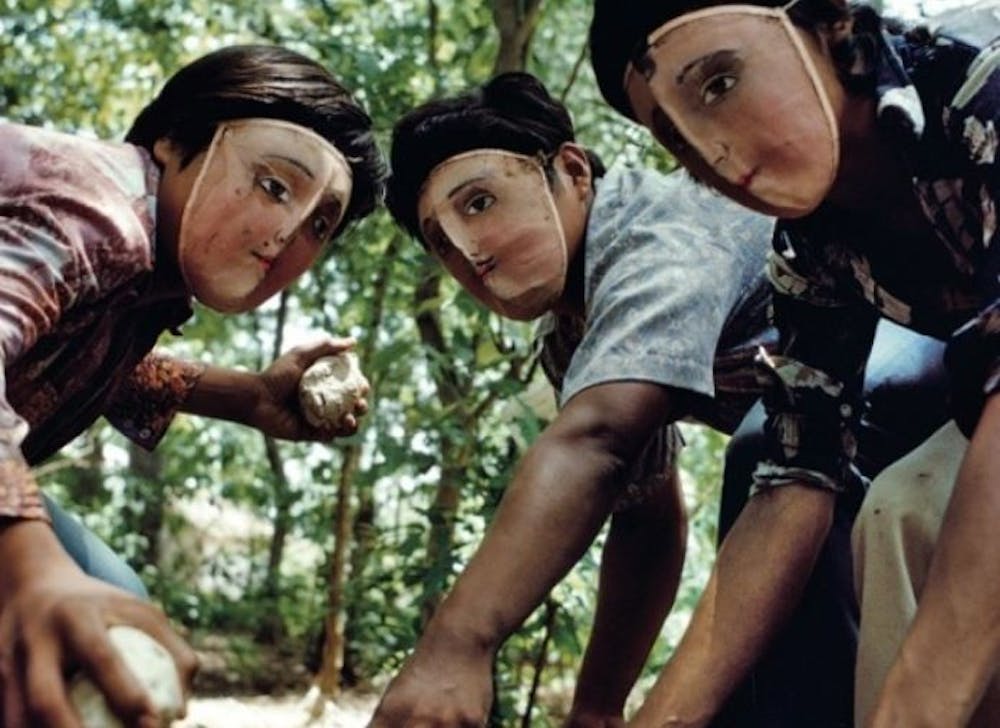Three photographers trekked to the midst of the Sandinista conflict in Nicaragua, to the most violent years of the Iraq War, and to the home of a fatally ill man and his wife in China for their work.
On Thursday, Oct. 18, the three photographers — Susan Meiselas, Peter van Agtmael, and Sim Chi Yin — also traveled to the University, where they discussed humanitarian photojournalism, along with their own inspirations and frustrations with the field.
Meiselas, best known for her work documenting human rights abuses in Latin America, has also photographed women performing stripteases at New England county fairs and women in refuges in the Black Country area of the West Midlands, England.
She is currently the Belknap Visiting Fellow in the Humanities Council and Department of English.
Meiselas focused on a single image she took during the Sandinista conflict, which depicted three men, their faces hidden behind traditional Nicaraguan folk masks, holding homemade bombs. The image appeared on the cover of The New York Times Magazine on July 30, 1978.
“Many read online and watch from afar,” Meiselas said.
Ultimately, Meiselas expressed frustration with the limits of photography.
Van Agtmael chose to become a photographer in the wake of the Sept. 11, 2001, terrorist attack. Since then, he has documented conflict zones in Iraq and Afghanistan, as well as the consequences of war in America.
Van Agtmael experienced Iraq at the peak of its violence and conflict.
“As a 24-year-old who turned 25 in Iraq, the scenes of violence I was witnessing had an incredible emotional effect on me,” he said.
Photography, van Agtmael suggested, can easily be robbed of its context and complexity, defeating the goal of the photographer.
He pointed to a photograph he took depicting an injured civilian in Mosul being treated by Americans. However, what the picture does not show is that the civilian was injured by an attack that intended to strike an American vehicle.

Therefore, van Agtmael explained, the civilian was injured because the Americans were there in the first place.
Like van Agtmael, Sim stated that who her work is seen by, and how it is interpreted, is one of her primary concerns.
“It became important to me that I be read in Chinese,” Sim said.
Sim became a professional photographer after working as a traditional journalist in China for over a decade.
“There are clear limits to doing advocacy with photography and visual journalism, depending on which country and which society you work in,” said Sim, a Nobel Peace Prize photographer.
She explained that she worked in closed or relatively closed societies, like Singapore and China, where there is no free press or tolerance for different points of view.
The lectures were followed with a discussion moderated by Katherine Bussard, the Peter C. Bunnell Curator of Photography at the Princeton University Art Museum.
Meiselas explained that Sarah Lawrence College, where she had studied, didn’t teach photography.
Van Agtmael received his B.A. in History from Yale in 2003. He added that, although he has never been interested in photography as single, “decontextualized” images, he has been interested in photography as a continuum.
Sim, who also earned bachelor’s and master’s degrees in history, had similar sentiments as van Agtmael.
“Photography is about slices of time, and the preservation aspect is really interesting to me,” Sim said.
Bussard then asked about the role of writing in photojournalism, wondering how the caption and text intersects with the photograph.
Sim explained that context of the photograph is crucial, especially for a personal project. She added that for long-term projects, she writes the story herself, in addition to the captions.
Van Agtmael said that captions are complements to his photographs. For example, he spent 13 years photographing the United States and its relationship to the world, “in the shadow of 9/11,” but all the pictures altogether only add to a few seconds of those years.
“Everything that came before, came after, that I felt, that I smelled — none of that can be captured in the picture,” he added. “The role that the text ultimately plays is as a complement.”
The photographers discussed the future of their field as it relates to technology.
“Could virtual reality get us to the point of empathy we seek? It has great potential,” Meiselas said.
The panel discussion, titled “Humanitarian Photojournalism: A History of the Present,” was co-sponsored by the Humanities Council and the Program in Journalism. The panel was held at 4:30 p.m. in the Betts Auditorium at the School of Architecture.
This article was updated on 9:48 p.m., October 20, 2018. A previous version of this article referred to Sim Chi Yin as 'Yin,' while her correct family name is 'Sim.' The ‘Prince’ regrets the error.








